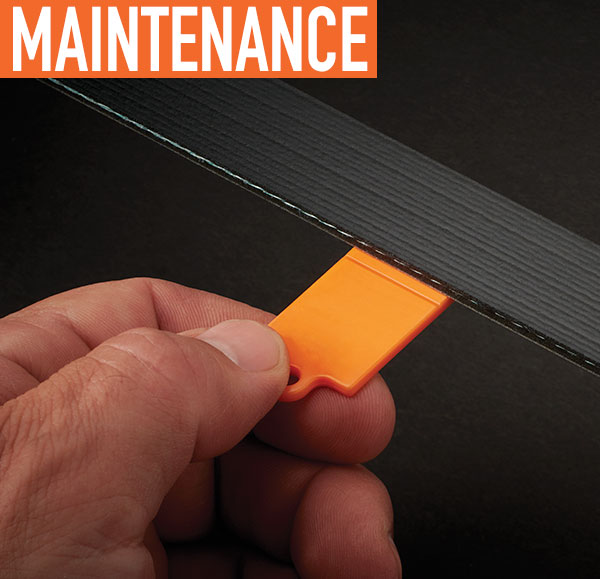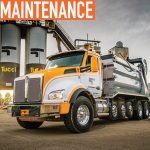Fleets have a different set of challenges to navigate as temperatures fluctuate and road conditions become a factor throughout the different seasons. Maintaining critical vehicle systems before seasonality sets in can help maximize vehicle investment and uptime.
A systems-centered approach to inspection and replacement will help ensure that vehicles are prepared for any season. Because all of the parts in a system are engineered to work in concert and wear at about the same rate, inspect and repair the full system instead of just a single part. Prepare vehicles now with the following best practices.
ABDS
Inspecting the critical Accessory Belt Drive System (ABDS) components at regular intervals is a practical way to prevent inconvenient breakdowns. When components wear, they put the entire system at risk. As a result, be sure to check all components of the ABDS system, including the belt, tensioner, idler pulleys, and the accessories.
Most belts on today’s commercial vehicles are made of ethylene propylene diene monomer (EPDM) material. While it lasts considerably longer than older belts constructed with chlorinated rubber (Neoprene), EPDM belts don’t exhibit traditional signs of wear, specifically when it comes to cracking. Consequently, a simple visual inspection usually can’t determine if a belt is at or near failure.
As an EPDM belt wears, the material is lost along the ribs, making the space between ribs wider. This results in poor performance, such as reduced wedging force between the belt and pulley. This can lead to belt slip, noise, and hydroplaning, which causes severe vibration and a reduced ability to transmit power, often leading to inconsistent accessory performance.
A simple way to check for belt wear is to use a belt wear gauge, which measures the amount of material loss of a belt. These gauges can be easily obtained from any belt manufacturer or parts distributor.
TENSIONER
An integral part of the ABDS is the tensioner: a device designed to maintain consistent tension on the belt. With a loss of tension, not only will accessory component performance be reduced due to the belt slipping, but the resulting heat generated from said belt slip will lead to premature belt failure.
It is common to view a tensioner as a hard part—something that does not wear and only requires replacement once it breaks. But, in reality, the internal components of a tensioner do wear and a tensioner’s lifespan is manufactured to match that of the belt.
Did you know a belt tensioner can cycle as much as a billion times every 100,000 miles? Not surprisingly, this relentless cycling will wear out the internal damper over time. Therefore, the only way to ensure a complete system repair is to inspect and replace the tensioner and belt at the same time.
Also, make sure to check that the idler pulleys smoothly connect the belt to the system. Worn pulleys can also cause misalignment and system performance issues.
SCR
Diesel engines that use SCR technology require special attention during the winter months. Freezing temperatures and harsh winter road conditions can wreak havoc on SCR systems, so it is especially important to maintain components.
High-quality hoses are necessary to circulate the diesel exhaust fluid (DEF) —which has a freezing temperature of 12 degrees Fahrenheit—required by SCR systems. It is critical to inspect all hoses in the SCR system to ensure that they are able to heat DEF quickly and uniformly. Gates’ design for SCR assemblies have a carbon fiber heating system that allows for more uniform fluid heating throughout the hose compared to heated-wire designs.

Equally important is to ensure that the hose end connectors are maintained and protected. Field tests have shown that moisture ingression can cause SCR assembly failure due to corrosion of electrical connections. Any cracking of connector ends indicates the immediate need for hose replacement before wet winter driving. Gates SCR assemblies have special thermoplastic over-molds to protect electrical connections against moisture and corrosion.
If the hose you are replacing is the same age as the other two, a combined replacement is recommended for complete repair on the SCR system. Keeping up with SCR system maintenance will ensure that it operates optimally.
COOLING SYSTEM
A vehicle’s cooling system can help prevent damage to the engine during extremely cold weather. Ensure the cooling system is operating at peak performance by reviewing all system components, including the radiator, tank cap, thermostat, water pump, radiator hoses, and clamps. Radiator damage, improper coolant mix, or blockage can diminish the system’s ability to cool the engine.
Hoses wear from the inside out and can be difficult to visually inspect. The reason for this is electrochemical degradation (ECD), which is the number one cause of hose failure. ECD is caused by an electrical charge carried through the coolant from component to component. It occurs because the hose, liquid coolant, and engine/radiator fittings form a galvanic cell or “battery.” This chemical reaction causes micro-cracks in the hose tube, allowing the coolant to attack and weaken the hose reinforcement.
Failures result from internal striations or cracks in the hose rubber, leading to a pinhole leak or a burst hose. One way to check a coolant hose for ECD is to squeeze the hose near its ends, adjacent to the clamps. If the ends feel softer than the middle of the hose there is a good chance ECD is occurring.
As a result, most of today’s hoses are now made with a specially formulated electrochemical resistant EPDM rubber to reduce this occurrence. That said, your best bet is to replace coolant hoses when servicing other critical cooling system components to ensure a complete repair.
Ultimately, a proactive, system-smart approach to vehicle maintenance can help fleets be prepared and better able to protect their vehicles from inconvenient breakdowns and expensive repairs in an effort to maximize uptime.
ABOUT THE AUTHOR
Matt Cleveland is the sales engineer, Heavy-Duty Market, for Gates Corporation. Drew Conkling is the product marketing manager, Belts and Accessory Component Kits, for Gates Corporation. Find out more about Gates Corporation, visit www.gates.com.
_______________________________________________________________________
MODERN WORKTRUCK SOLUTIONS: April 2017 ISSUE
Did you enjoy this article?
Subscribe to the FREE Digital Edition of Modern WorkTruck Solutions magazine.
![]()




